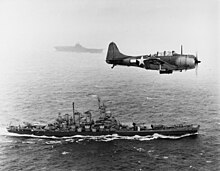Pacific Ocean theater of World War II




The Pacific Ocean theater of World War II was a major theater of the Pacific War, the war between the Allies and the Empire of Japan. It was defined by the Allied powers' Pacific Ocean Area command, which included most of the Pacific Ocean and its islands, while mainland Asia was excluded, as were the Philippines, the Dutch East Indies, Borneo, Australia, most of the Territory of New Guinea, and the western part of the Solomon Islands.
History
It officially came into existence on March 30, 1942, when US
Most Japanese forces in the theater were part of the
In the Pacific Ocean theater, Japanese forces fought primarily against the United States Navy, the U.S. Army, which had 6 Corps and 21 Divisions, and the U.S. Marine Corps, which had only 6 Divisions. The United Kingdom (British Pacific Fleet), New Zealand, Australia, Canada, and other Allied nations, also contributed forces.
Major campaigns and battles
- Pacific theater
- Attack on Pearl Harbor 7 December 1941[4]
- Battle of Wake Island 7–23 December 1941[5]
- Philippines campaign 8 December 1941 – 8 May 1942
- Battle of Ambon
- Battle of Timor
- Battle of Rabaul
- Battle of the Java Sea
- Bombing of Darwin
- Battle of the Coral Sea 4–8 May 1942
- Doolittle Raid 18 April 1942[4]
- Battle of Midway 4–7 June 1942[4]
- Guadalcanal campaign 7 August 1942 to 9 February 1943
- Battle of Savo Island
- Battle of Cape Esperance
- Second Naval Battle of Guadalcanal
- Battle of Tassafaronga
- New Guinea campaign
- Solomon Islands Campaign
- Battle of the Bismark Sea
- Gilbert and Marshall Islands campaign 1943–44
- Makin Island raid 17–18 August 1942[6]
- Battle of Tarawa 20 November 1943[4]
- Battle of Makin 20–23 November 1943
- Battle of Kwajalein 14 February 1944[7]
- Battle of Eniwetok 17 February 1944[8]
- Attack on Truk Island 17–18 February 1944
- Mariana and Palau Islands campaign 1944
- Battle of Saipan 15 June 1944[9]
- Battle of the Philippine Sea 19–21 June 1944[10]
- Battle of Guam 21 July 1944[11]
- Battle of Tinian 24 July 1944[11]
- Battle of Peleliu 15 September 1944[12]
- Battle of Angaur 17 September 1944[12]
- Battle of Leyte 17 October 1944
- Battle of Luzon 9 January 1945
- Battle of Iwo Jima 19 February 1945[4]
- Battle of Okinawa 1 April 1945[4]
- North Pacific theater
- Aleutian Islands Campaign1942–43
- Battle of the Komandorski Islands 26 March 1943[4]
References
- ^ Cressman 2000, p. 84.
- ^ a b Potter & Nimitz 1960, p. 717.
- ^ Potter & Nimitz 1960, pp. 759–60.
- ^ a b c d e f g Silverstone 1968, pp. 9–11.
- ^ Potter & Nimitz 1960, pp. 651–62.
- ^ Kafka & Pepperburg 1946, p. 185.
- ^ Potter & Nimitz 1960, p. 751.
- ^ Ofstie 1946, p. 194.
- ^ Potter & Nimitz 1960, p. 761.
- ^ Potter & Nimitz 1960, p. 765.
- ^ a b Potter & Nimitz 1960, p. 770.
- ^ a b Ofstie 1946, p. 275.
Bibliography
- Cressman, Robert J. (2000), The Official Chronology of the U.S. Navy in World War II, Annapolis, ISBN 1-55750-149-1.
- Drea, Edward J. (1998), In the Service of the Emperor: Essays on the Imperial Japanese Army, ISBN 0-8032-1708-0.
- Hakim, Joy (1995), A History of Us: War, Peace and All That Jazz, New York: Oxford University Press, ISBN 0-19-509514-6.
- Kafka, Roger; Pepperburg, Roy L. (1946), Warships of the World, New York: Cornell Maritime Press.
- Miller, Edward S. (2007), War Plan Orange: The U.S. Strategy to Defeat Japan, 1897–1945, US Naval Institute Press, ISBN 978-1-59114-500-4.
- Ofstie, Ralph A. (1946). The Campaigns of the Pacific War. Washington, DC: United States Government Printing Office..
- Potter, E. B.; Nimitz, Chester W. (1960), Sea Power, Prentice-Hal.
- Silverstone, Paul H. (1968), U.S. Warships of World War II, Doubleday & Co.
- Pacific Crucible: War at Sea in the Pacific, 1941–1942. New York: W. W. Norton.
- ——— (2015). The Conquering Tide: War in the Pacific Islands, 1942–1944. New York: W. W. Norton.
- ——— (2020). Twilight of the Gods: War in the Western Pacific, 1944–1945. New York: W. W. Norton.
